MaryAnn Bernal's Blog, page 303
March 18, 2014
Giant steps: mysterious Sardinian sculptures to go on display
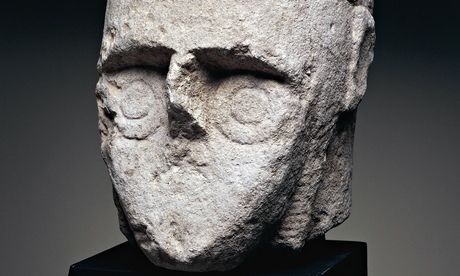 The head of a warrior: one of the Giants of Monte Prama. Photograph: M Carrieri/De Agostini/Getty Images John Hooper in Rome theguardian.com, The Giants of Monte Prama, inscrutable avatars of a lost civilisation, see the light after years of reconstruction work Some of the most mysterious statues from antiquity are finally to go on permanent display this week – 40 years after they were discovered by a ploughman on the Italian island of Sardinia.
The head of a warrior: one of the Giants of Monte Prama. Photograph: M Carrieri/De Agostini/Getty Images John Hooper in Rome theguardian.com, The Giants of Monte Prama, inscrutable avatars of a lost civilisation, see the light after years of reconstruction work Some of the most mysterious statues from antiquity are finally to go on permanent display this week – 40 years after they were discovered by a ploughman on the Italian island of Sardinia.The Giants of Monte Prama include statues of archers, wrestlers and boxers carved in sandstone probably between the ninth and eight centuries BC, before Rome was even founded. They belong to the Nuragic civilisation, which flourished on Sardinia for two millennia until the second century AD.
The figures, standing over 2 metres (6.5ft) high, are distinguished by their unearthly eyes, which consist of two perfectly concentric circles. They – or rather, their component parts – were found in 1974 near the town of Cabras, on the west coast of the island.
But it was not until recently that funds were set aside for the daunting task of reconstructing the statues, which also include representations of nuraghe, the tower-fortresses after which the Nuragic civilisation is named. More than 5,000 pieces were dug up at the site.
Alessandro Usai, the curator of the permanent exhibition, which opens on Saturday at the national archaeological museum, in Cagliari, and the town museum of Cabras, said computers had been of limited use in the operation. "Most of the work was done by eye and by hand, using shape, type of stone and decoration as guides," he told the Guardian. The reconstruction, which was completed in 2011, took four years.
The figures were discovered at a necropolis , so one theory is that the stone warriors guarded the tombs. But it has also been suggested that they belonged to an as-yet undiscovered nearby temple.
Usai said many other questions remained: "We don't know how many there were altogether. Nor do we know if they were originally set out in lines or perhaps in squares."
Usai said 28 of the works would go on show in Cagliari, while another 10 would be displayed in Cabras, where it is hoped the Giants will help promote tourism.
Usai said three-dimensional digital representations of the missing statues would be created at each site, "so that the two exhibitions will be complementary".
http://www.theguardian.com/world/2014/mar/17/giants-of-monte-prama-sardinian-sculptures-display

Published on March 18, 2014 04:36
History Trivia - Edward, the Martyr, King of Anglo-Saxons murdered
March 18
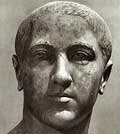
235 Emperor Alexander Severus and his mother Julia Mamaea were murdered by legionaries near Moguntiacum (modern Mainz), ending the Severan dynasty.

978 Edward, the Martyr, King of Anglo-Saxons was murdered
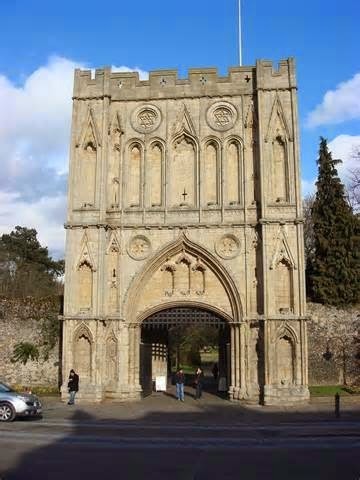
1190 Crusaders killed 57 Jews in Bury St Edmonds England.

1227 Pope Honorius III Died. His pontificate concentrated on church reform and the crusades.
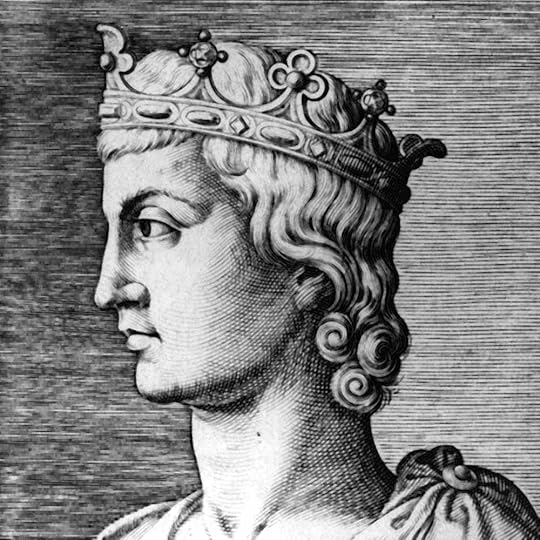
1229 Frederick II, Holy Roman Emperor declared himself King of Jerusalem during the Sixth Crusade.
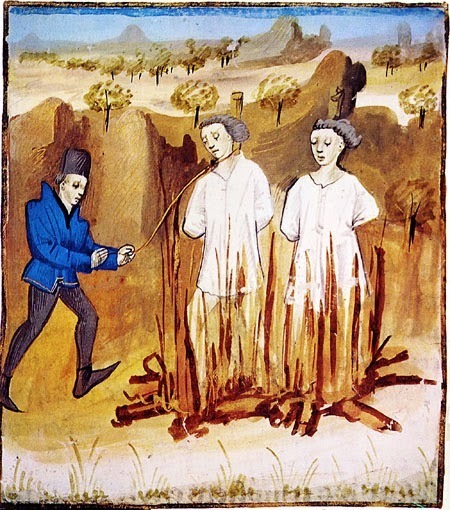
1314 Jacques de Molay, the 23rd and the last Grand Master of the Knights Templar, was burned at the stake.
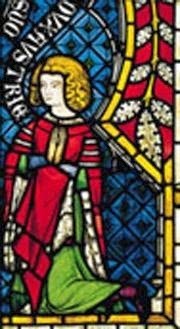 1438 Albert II of Habsburg became Holy Roman Emperor
1438 Albert II of Habsburg became Holy Roman Emperor


235 Emperor Alexander Severus and his mother Julia Mamaea were murdered by legionaries near Moguntiacum (modern Mainz), ending the Severan dynasty.

978 Edward, the Martyr, King of Anglo-Saxons was murdered

1190 Crusaders killed 57 Jews in Bury St Edmonds England.

1227 Pope Honorius III Died. His pontificate concentrated on church reform and the crusades.

1229 Frederick II, Holy Roman Emperor declared himself King of Jerusalem during the Sixth Crusade.

1314 Jacques de Molay, the 23rd and the last Grand Master of the Knights Templar, was burned at the stake.
 1438 Albert II of Habsburg became Holy Roman Emperor
1438 Albert II of Habsburg became Holy Roman Emperor

Published on March 18, 2014 04:35
March 17, 2014
Mr. Chuckles snags the Kindle edition of The Night Porter by Mark Barry

Mr. Chuckles is proud to announce the kindle release of The Night Porter by Mark Barry and is sharing this excerpt:
‘I know what you’re thinking,’ he says. ‘After all I’ve said.’‘What am I thinking?’ I reply, knowing full well he knows what I am thinking. How I gave it away, I do not know! I must be losing my poker face.‘That I’m the same as the rest of them. A celebrity junkie.’‘Julian – ’‘Don’t worry, I wouldn’t blame you. I’m hypocritical at times, especially when it comes to publicity. Every writer wants their book read, at heart. There’s a big distinction. Authors are the professional arm. They’re all about the money and the sales. The reach. They’re all about the rewards and the lifestyle. Writers want their work read. We’re artists. I couldn’t give a Joe Loss about the money, but I want people to read my book. This is an opportunity. This is MY reach, fella. All the press in one hit. My stuff. Me. It’s all hypocritical, I know it is, but tell me where I can get this kind of exposure on the Internet? I’ve told you before. You put your book up on Twitter and before you know it, twenty other authors have put theirs up. It’s a bazaar. They’re – we – are like lice on a tramp’s jockstrap.’‘So you’ve mentioned.’‘Here is a chance to bust out of that. The broadsheets got hold of my book, but who reads the broadsheets!? Fifty of the best national literary mouthpieces in one room. Of COURSE, I’m going to be excited. On top of the press, you’ve got the book bloggers connected to Tarzan. The best reviewers in the business, and they aren’t averse to self pubs, if they’ve sold or attracted attention. I’ve seen the list and I salivated, chap. You’ve got Fiona Faithful from BuyBooks.com. Lenny Cotton from Overtherainbow. Michaela Groves from The Eye. Keanu Lantern from Bigapplelibrary.com is over and attending the conference and ceremony. Private bloggers. Serious judges of literary form. They can spot a good book from a thousand paces. They can sniff one out from the thousands pubbed every month, and they can ensure that book gets out there. Their word is a literary papal bull, a weekly sermon on the mount, the tablets of stone propped up next to the burning bush. One word from these guys, and readers will read your book. Do you know how many book buyers follow these book bloggers? Thousands of them. Thousands. And their readers buy – they don’t just read the reviews and stare blankly into space like lemons. Veni Vidi Visa. I came. I saw. Out came my credit card. These are a dream come true, the cream of the crop. It’s okay me being Morrissey-like on the top table, but I would be stupid like that. Once a week they feature a book. They put up an extract and they review you. They can make you. They can destroy you. These guys are THE oxygen tanks of publicity.’‘I haven’t seen you as excited as this, Julian.’‘I’m on FIRE, chap,’ he says, giving me a high five.
Want more? Click on the purchase links
Amazon US
http://www.amazon.com/The-Night-Porter-Mark-Barry-ebook/dp/B00J1LJZPA/ref=sr_1_2?ie=UTF8&qid=1395058992&sr=8-2&keywords=the+NIght+porter+by+mark+barry
Amazon UK
http://www.amazon.co.uk/The-Night-Porter-Mark-Barry-ebook/dp/B00J1LJZPA/ref=sr_1_1?ie=UTF8&qid=1395058922&sr=8-1&keywords=the+night+porter+by+mark+barry
PRINT EDITION COMING SOON!

Published on March 17, 2014 09:56
Secrets of Chinese Terra-Cotta Warrior Weapons Revealed
By Tia Ghose, Staff Writer
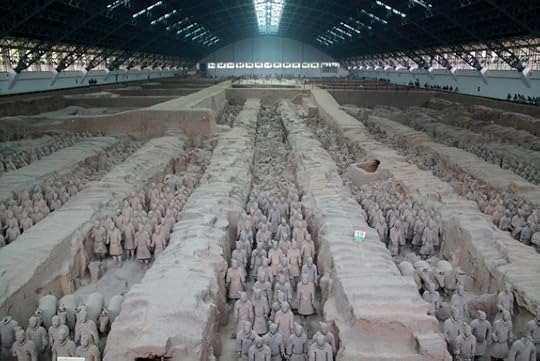 About 8,000 Terracotta Warriors were buried in three pits less than a mile to the northeast of the mausoleum of the First Emperor of China, Qin Shi Huangdi. They include infantryman, archers, cavalry, charioteers and generals. Now new research, including newly translated ancient records, indicates that the construction of these warriors was inspired by Greek art.
About 8,000 Terracotta Warriors were buried in three pits less than a mile to the northeast of the mausoleum of the First Emperor of China, Qin Shi Huangdi. They include infantryman, archers, cavalry, charioteers and generals. Now new research, including newly translated ancient records, indicates that the construction of these warriors was inspired by Greek art.
Credit: Lukas Hlavac One of the most astounding archaeological discoveries of the 20th century is arguably the life-size terra-cotta army buried alongside China's first emperor. Now, scientists have figured out how the bronze triggers for the crossbows of the 8,000 terra-cotta warriors were manufactured.Teams of craftspeople worked in small groups to produce the bronze pieces in batches for the tomb of ancient Emperor Qin Shi Huang, according to a new study detailed in the March issue of the journal Antiquity. Prepared for the afterlife Historical documents suggest that soon after Emperor Qin Shi Huang ascended to the throne in 246 B.C., he began work on his tomb near Xi'an, China. When the tomb was first unearthed in the 1970s,it revealed thousands of lifelike terra-cotta statues of artisans, musicians, officials, horses and soldiers. The epic effort conscripted 700,000 laborers, many of whom were convicts or people who were in debt to the empire, said study co-author Xiuzhen Janice Li, an archaeologist who was at the University College London at the time of the new work and is now at the Emperor Qin Shi Huang’s Mausoleum Site Museum in China. [In Images: Ancient Chinese Warriors Protect Secret Tomb]The massive undertaking had an important goal: ensuring the emperor's military power and resources in the afterlife.
As part of the huge project, craftspeople sculpted about 8,000 colorful warriors — likely using real human beings as inspiration — and those warriors wore stone armor and "wielded" lances, swords and crossbows.
But it wasn't clear exactly how these ancient weapons were made. The crossbows were made of wood or bamboo that rotted long ago, and only the tips and triggers for the bows remained, Li told Live Science.
Small workshops
To learn more about how the massive trove was built, Li and her colleagues visually inspected and measured about 216 of the five-part crossbow triggers from the mausoleum.
The lack of wear on the metal pieces suggests the weapons were never used in actual battle, but were instead built solely for the tomb, the researchers said.
One of the most astounding archaeological discoveries of the 20th century is arguably the life-size terra-cotta army buried alongside China's first emperor. Now, scientists have figured out how the bronze triggers for the crossbows of the 8,000 terra-cotta warriors were manufactured.
Teams of craftspeople worked in small groups to produce the bronze pieces in batches for the tomb of ancient Emperor Qin Shi Huang, according to a new study detailed in the March issue of the journal Antiquity.
Prepared for the afterlife
Historical documents suggest that soon after Emperor Qin Shi Huang ascended to the throne in 246 B.C., he began work on his tomb near Xi'an, China. When the tomb was first unearthed in the 1970s,it revealed thousands of lifelike terra-cotta statues of artisans, musicians, officials, horses and soldiers. The epic effort conscripted 700,000 laborers, many of whom were convicts or people who were in debt to the empire, said study co-author Xiuzhen Janice Li, an archaeologist who was at the University College London at the time of the new work and is now at the Emperor Qin Shi Huang’s Mausoleum Site Museum in China. [In Images: Ancient Chinese Warriors Protect Secret Tomb]The massive undertaking had an important goal: ensuring the emperor's military power and resources in the afterlife.
As part of the huge project, craftspeople sculpted about 8,000 colorful warriors — likely using real human beings as inspiration — and those warriors wore stone armor and "wielded" lances, swords and crossbows.
But it wasn't clear exactly how these ancient weapons were made. The crossbows were made of wood or bamboo that rotted long ago, and only the tips and triggers for the bows remained, Li told Live Science.
Small workshops
To learn more about how the massive trove was built, Li and her colleagues visually inspected and measured about 216 of the five-part crossbow triggers from the mausoleum.
The lack of wear on the metal pieces suggests the weapons were never used in actual battle, but were instead built solely for the tomb, the researchers said.
In addition, the team analyzed the spots where triggers were found in the tomb, as well as the variation in the size and shape of the pieces.
The pieces were mostly uniform, suggesting the interlocking trigger parts were made in the same or nearly-identical molds and produced in small batches. Each batch of the trigger pieces was likely then assembled in small cells, or workshops, perhaps headed by an overseer. That model contrasts with the "assembly line" hypothesis that some archaeologists thought might have been used.
Mirror of society
The organization into small workshops was similar to the structure the emperor imposed on the rest of society in ancient China, said study co-author Marcos Martinón-Torres, an archaeologist at the University College London.
"He abolished any privileges inherited by blood, and the population was divided in small groups that were collectively responsible for their adherence to imperial laws," Martinón-Torres wrote in an email to Live Science. "For example, if someone in one of these groups committed a crime, all of them were held responsible, unless they reported the culprit and allowed them to be punished."
The manufacturing technique used in the workshop also may have been used by weapon makers for the Emperor of Qin's real armies, though that's just speculation, Martinón-Torres said.
"The cellular workshop model we postulate for the weapons manufacture in the mausoleum would have also offered useful flexibility for armies on the move," he said.
Follow Tia Ghose on Twitter and Google+ . Follow Live Science @livescience , Facebook & Google+ . Original article on Live Science .
http://www.livescience.com/44024-terracotta-warrior-weapons-construction.html
 About 8,000 Terracotta Warriors were buried in three pits less than a mile to the northeast of the mausoleum of the First Emperor of China, Qin Shi Huangdi. They include infantryman, archers, cavalry, charioteers and generals. Now new research, including newly translated ancient records, indicates that the construction of these warriors was inspired by Greek art.
About 8,000 Terracotta Warriors were buried in three pits less than a mile to the northeast of the mausoleum of the First Emperor of China, Qin Shi Huangdi. They include infantryman, archers, cavalry, charioteers and generals. Now new research, including newly translated ancient records, indicates that the construction of these warriors was inspired by Greek art.Credit: Lukas Hlavac One of the most astounding archaeological discoveries of the 20th century is arguably the life-size terra-cotta army buried alongside China's first emperor. Now, scientists have figured out how the bronze triggers for the crossbows of the 8,000 terra-cotta warriors were manufactured.Teams of craftspeople worked in small groups to produce the bronze pieces in batches for the tomb of ancient Emperor Qin Shi Huang, according to a new study detailed in the March issue of the journal Antiquity. Prepared for the afterlife Historical documents suggest that soon after Emperor Qin Shi Huang ascended to the throne in 246 B.C., he began work on his tomb near Xi'an, China. When the tomb was first unearthed in the 1970s,it revealed thousands of lifelike terra-cotta statues of artisans, musicians, officials, horses and soldiers. The epic effort conscripted 700,000 laborers, many of whom were convicts or people who were in debt to the empire, said study co-author Xiuzhen Janice Li, an archaeologist who was at the University College London at the time of the new work and is now at the Emperor Qin Shi Huang’s Mausoleum Site Museum in China. [In Images: Ancient Chinese Warriors Protect Secret Tomb]The massive undertaking had an important goal: ensuring the emperor's military power and resources in the afterlife.
As part of the huge project, craftspeople sculpted about 8,000 colorful warriors — likely using real human beings as inspiration — and those warriors wore stone armor and "wielded" lances, swords and crossbows.
But it wasn't clear exactly how these ancient weapons were made. The crossbows were made of wood or bamboo that rotted long ago, and only the tips and triggers for the bows remained, Li told Live Science.
Small workshops
To learn more about how the massive trove was built, Li and her colleagues visually inspected and measured about 216 of the five-part crossbow triggers from the mausoleum.
The lack of wear on the metal pieces suggests the weapons were never used in actual battle, but were instead built solely for the tomb, the researchers said.
One of the most astounding archaeological discoveries of the 20th century is arguably the life-size terra-cotta army buried alongside China's first emperor. Now, scientists have figured out how the bronze triggers for the crossbows of the 8,000 terra-cotta warriors were manufactured.
Teams of craftspeople worked in small groups to produce the bronze pieces in batches for the tomb of ancient Emperor Qin Shi Huang, according to a new study detailed in the March issue of the journal Antiquity.
Prepared for the afterlife
Historical documents suggest that soon after Emperor Qin Shi Huang ascended to the throne in 246 B.C., he began work on his tomb near Xi'an, China. When the tomb was first unearthed in the 1970s,it revealed thousands of lifelike terra-cotta statues of artisans, musicians, officials, horses and soldiers. The epic effort conscripted 700,000 laborers, many of whom were convicts or people who were in debt to the empire, said study co-author Xiuzhen Janice Li, an archaeologist who was at the University College London at the time of the new work and is now at the Emperor Qin Shi Huang’s Mausoleum Site Museum in China. [In Images: Ancient Chinese Warriors Protect Secret Tomb]The massive undertaking had an important goal: ensuring the emperor's military power and resources in the afterlife.
As part of the huge project, craftspeople sculpted about 8,000 colorful warriors — likely using real human beings as inspiration — and those warriors wore stone armor and "wielded" lances, swords and crossbows.
But it wasn't clear exactly how these ancient weapons were made. The crossbows were made of wood or bamboo that rotted long ago, and only the tips and triggers for the bows remained, Li told Live Science.
Small workshops
To learn more about how the massive trove was built, Li and her colleagues visually inspected and measured about 216 of the five-part crossbow triggers from the mausoleum.
The lack of wear on the metal pieces suggests the weapons were never used in actual battle, but were instead built solely for the tomb, the researchers said.
In addition, the team analyzed the spots where triggers were found in the tomb, as well as the variation in the size and shape of the pieces.
The pieces were mostly uniform, suggesting the interlocking trigger parts were made in the same or nearly-identical molds and produced in small batches. Each batch of the trigger pieces was likely then assembled in small cells, or workshops, perhaps headed by an overseer. That model contrasts with the "assembly line" hypothesis that some archaeologists thought might have been used.
Mirror of society
The organization into small workshops was similar to the structure the emperor imposed on the rest of society in ancient China, said study co-author Marcos Martinón-Torres, an archaeologist at the University College London.
"He abolished any privileges inherited by blood, and the population was divided in small groups that were collectively responsible for their adherence to imperial laws," Martinón-Torres wrote in an email to Live Science. "For example, if someone in one of these groups committed a crime, all of them were held responsible, unless they reported the culprit and allowed them to be punished."
The manufacturing technique used in the workshop also may have been used by weapon makers for the Emperor of Qin's real armies, though that's just speculation, Martinón-Torres said.
"The cellular workshop model we postulate for the weapons manufacture in the mausoleum would have also offered useful flexibility for armies on the move," he said.
Follow Tia Ghose on Twitter and Google+ . Follow Live Science @livescience , Facebook & Google+ . Original article on Live Science .
http://www.livescience.com/44024-terracotta-warrior-weapons-construction.html

Published on March 17, 2014 08:14
450-Million-Year-Old Marine Creatures 'Babysat' Their Young
By Becky Oskin, Senior Writer
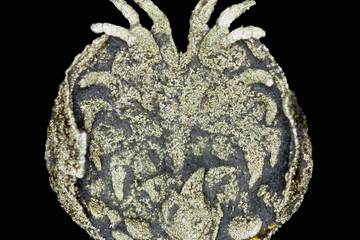 A newly discovered fossil ostracod called Luprisca incuba, showing limbs and eggs, from 450-million-year old rocks in NewYork.
A newly discovered fossil ostracod called Luprisca incuba, showing limbs and eggs, from 450-million-year old rocks in NewYork.
Credit: Siveter, David J., Tanaka, G., Farrell, C. Ú., Martin, M.J., Siveter, Derek J & Briggs, D.E.G.
The oldest fossil evidence of animal "babysitting" now comes from 450-million-year-old rocks in New York.
Small marine animals called ostracods, a group of crustaceans that includes more than 20,000 species living today, were discovered buried with their eggs and young by a team led by researchers from the University of Leicester in Britain. The findings were published today (March 13) in the journal Current Biology.
"This is a very rare and exciting find from the fossil record," David Siveter, lead study author and a geologist at the University of Leicester, said in a statement. "Only a handful of examples are known where eggs are fossilized and associated with the parent. This discovery tells us that these ancient, tiny marine crustaceans took particular care of their brood in exactly the same way as their living relatives."
http://www.livescience.com/44088-fossil-evidence-egg-care-ostracods.html
 A newly discovered fossil ostracod called Luprisca incuba, showing limbs and eggs, from 450-million-year old rocks in NewYork.
A newly discovered fossil ostracod called Luprisca incuba, showing limbs and eggs, from 450-million-year old rocks in NewYork.Credit: Siveter, David J., Tanaka, G., Farrell, C. Ú., Martin, M.J., Siveter, Derek J & Briggs, D.E.G.
The oldest fossil evidence of animal "babysitting" now comes from 450-million-year-old rocks in New York.
Small marine animals called ostracods, a group of crustaceans that includes more than 20,000 species living today, were discovered buried with their eggs and young by a team led by researchers from the University of Leicester in Britain. The findings were published today (March 13) in the journal Current Biology.
"This is a very rare and exciting find from the fossil record," David Siveter, lead study author and a geologist at the University of Leicester, said in a statement. "Only a handful of examples are known where eggs are fossilized and associated with the parent. This discovery tells us that these ancient, tiny marine crustaceans took particular care of their brood in exactly the same way as their living relatives."
http://www.livescience.com/44088-fossil-evidence-egg-care-ostracods.html

Published on March 17, 2014 08:02
World's Oldest Masks Show Creepy Human Resemblance
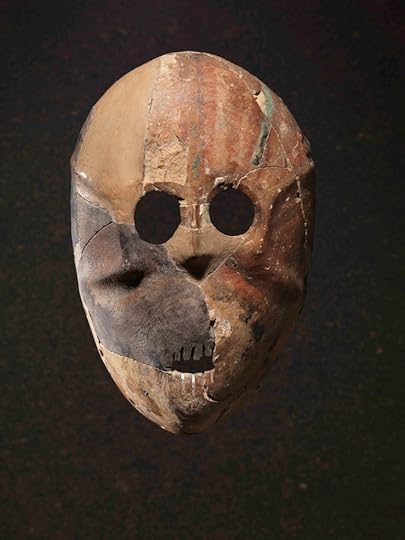 Researchers think these masks could have been worn comfortably on the face during ancient rituals. This mask comes from the site of Horvat Duma in the Judean Hills.Billed as "the oldest masks in the world," a creepy collection of 9,000-year-old stone faces is now on display in Israel. With stilted smiles and large eyeholes, the artifacts are thought to have represented the spirits of dead ancestors and may have been worn during Stone Age ceremonies and rituals, researchers say.
Researchers think these masks could have been worn comfortably on the face during ancient rituals. This mask comes from the site of Horvat Duma in the Judean Hills.Billed as "the oldest masks in the world," a creepy collection of 9,000-year-old stone faces is now on display in Israel. With stilted smiles and large eyeholes, the artifacts are thought to have represented the spirits of dead ancestors and may have been worn during Stone Age ceremonies and rituals, researchers say.Before putting the rare artifacts inside glass cases at the Israel Museum in Jerusalem, the curators say they brought the masks together for a comparative study. Three-dimensional modeling showed that most of the masks could have been placed comfortably on the face, curator Debby Hershman said.
"The eye holes allow for a wide field of vision, and the comfortable apportioning of the mass is suited to human facial contours," Hershman told Live Science in an email
There are also holes on the edges of some of the ancient masks, which may have been used to attach them to the face. Alternatively, these perforations might have been threaded with hair to make the masks look more human or with cords to suspend the masks from pillars or other structures.
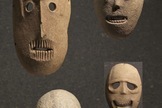 [image error]The masks come from various sites in the Judean Desert and the Judean hills, according to the museum. The artifacts date back to the Neolithic era, when humans started giving up nomadic lifestyles in favor of permanent settlements, complete with farms and domesticated animals.
[image error]The masks come from various sites in the Judean Desert and the Judean hills, according to the museum. The artifacts date back to the Neolithic era, when humans started giving up nomadic lifestyles in favor of permanent settlements, complete with farms and domesticated animals.Two of the stone masks were already in the museum's collection; one came from the Nahal Hemar cave in a cliff close to the Dead Sea and the second had been found at the nearby archaeological site of Horvat Duma.
The other artifacts are on loan from the private collection of Judy and Michael Steinhardt of New York. None of those objects have a known provenance, but based on analyses of the material, researchers think most of the masks came from the Judean hills or Judean foothills.
The exhibition, "Face to Face: The Oldest Masks in the World," will be on view through Sept. 13.
Follow Megan Gannon on Twitter and Google+. Follow us @livescience , Facebook & Google+ . Original article on Live Science.
http://www.livescience.com/44078-stone-age-masks-israel-museum.html

Published on March 17, 2014 07:56
HS2 rail link: archaeologists and English Heritage clash over the route through a nation's past

Edgcote, Northamptonshire: the Wars of the Roses battlefield lies on the line of the HS2 rail link. Photograph: Colin Underhill/Alamy
Robin Stummer
The Observer Archaeologists say that a unique 350-mile trench will open up the buried past, while English Heritage condemns lack of attention to the environment To archaeologists, the HS2 high-speed rail scheme is "one huge trench across the country", an unprecedented 350-mile bonanza that promises to open up England's ancient backbone and shoulders for meticulous study in a way never before possible. To many historians, however, it is a colossal folly, an unwarranted assault on the nation's historic heartlands that will dislocate a wealth of precious links with the past.
Even supporters of HS2 concede that the cost to heritage of building the line is likely to be high. Opponents see the resulting gain in travel time, expressed as minutes here and there, set against centuries lost to the bulldozer.
If it goes ahead, HS2 would pass through an extraordinary range of historic landscapes, from inner London Victoriana to home counties Tudor and Elizabethan, then on to Midlands medieval and industrial, and northwards to houses and gardens in the grand style. And everywhere there is archaeology, much of it untouched and so far largely unidentified, the shards and stones of pre-Reformation and ancient Britain.
Yet, despite widespread awareness of the importance of this rich seam of history, English Heritage, the government's adviser on the historic environment, has issued a highly critical report on the heritage assessment work being carried out by HS2 Ltd, the company set up by the government to oversee the delivery of the line, before work begins. In its recently published response to the environmental statement on heritage affected by phase one of HS2, prepared by HS2 Ltd as a statutory requirement, English Heritage attacks the quality of historic environment assessment work by the company.
It criticises HS2 Ltd for failing to carry out essential fieldwork, without which "it is impossible for us to assess" what remains may be in danger: "We consider there is a realistic likelihood that archaeological remains of national importance… will be affected, but have not yet been identified and described."
Singled out for criticism by English Heritage is HS2 Ltd's lack of detailed work on the historic environment in the Chilterns, an area of outstanding natural beauty and an archaeological hotspot. "Discussion of it is limited to two paragraphs, and the impacts on it limited to three," says English Heritage.
Buckinghamshire county council estimates that some 7,000 designated heritage assets will be affected by the London to Birmingham phase of HS2 alone. This includes ancient field boundaries and tracks, historic buildings, hamlets, villages and major archaeological sites. The actual number at risk could be far higher, since that figure excludes historic buildings, sites and remains which have no statutory protection – a large proportion of them.
English Heritage has identified a series of listed historic assets of national importance that would be destroyed or badly affected by the first phase of construction. In Camden, north London, where a new terminus for HS2 is proposed for Euston station, English Heritage mentions St James's Gardens burial ground and park, last resting place of some 50,000 Londoners. Other places of concern include Doddershall medieval village site in Buckinghamshire, and a Roman villa and a wars of the roses battlefield at Edgcote, Northamptonshire, along with medieval farmhouses and pre-Roman sites.
Also highlighted in English Heritage's response is Grim's Ditch, a large, ancient earthwork skirting Wendover in Buckinghamshire. Despite scheduled monument status, HS2 would run through it, destroying a 150-metre section.
But the actual toll could be far higher than the English Heritage list suggests. Opponents of HS2 argue that the "damage zone" extends far beyond the immediate vicinity of the high-speed lines, unpicking in a few years a delicate fabric formed over centuries. Warwickshire county council calls the impact of the scheme "devastating on our countryside and our communities".
"This landscape has survived as it was since at least 1620," says writer Alison Doggett, an expert on the Chilterns. The region, much of which is statutorily protected, will be cut through by HS2. Tunnels will hide a proportion of the line, but one historic area, the Missenden valley, will be dissected diagonally by miles of concrete viaducts and embankments.
"I have matched a map from 1620 against the valley as it is now and, astonishingly, the patterns are there, exactly the same – the hedges, the fields, the lanes," says Doggett. "Under HS2 they will take these tiny lanes, with high sides, tree tunnels, some of them Anglo-Saxon, and are going to widen the roads and rip out the hedges and the banks, for lorries. There are three lanes in particular they're going to remove, which are all on the 1620 map. Once they're gone, they're gone."
Less than two miles from the Missenden valley – but sheltered by a ridge from construction work and near-perpetual train noise – is Chequers, the prime minister's country retreat.
Opponents of HS2 believe that the heritage risk assessments are flawed. "This area is an AONB – that's national heritage, the whole area, and it all hangs together as a mosaic," says Steve Rodrick, chief officer of the Chiltern Conservation Board. "It's the sum of its parts. The government doesn't understand that. "It doesn't understand that heritage is a lot of inter-relationships with a time depth. It's fragmented all those elements. The Chilterns are a national asset and we are all stewards of a national treasure, and the ultimate responsibility, ironically, rests with government and parliament. Yet they are failing in that stewardship."
But not all professional historians are wary of HS2. "From an archaeological point of view, this is an opportunity," says Dr Mike Heyworth, director of the Council for British Archaeology. He sees HS2 as a "huge trench across the country where we can learn an awful lot about new sites. As long as the procedures are followed properly and the archaeologists are given enough time on site and there are adequate resources to do their work, that shouldn't be a problem. We're in touch with HS2 Ltd and have been involved with them in high-level negotiations and discussions, principally about routes, at a local level. This is the largest-ever opportunity for archaeological investigation in one go."
Dr Heyworth acknowledges that the prospect of the unprecedented tidal wave of archaeological work which would arise from HS2 – against the clock, on a tight budget, and amid unprecedented cuts in funding in the heritage sector – would place a severe strain on the profession.
"There will be a shortage of skills and manpower. There's been a shrinkage in the number of professional archaeologists, and a loss of skills. And if suddenly we're getting a lot of new housing and building development, we're going to run out of archaeologists. We won't have the skills base we need to do a professional job.
"One solution may be to bring in archaeologists from other parts of the world, and certainly our colleagues across Europe are very well trained and experienced. There are some who would argue that you don't need that academic background... you don't necessarily have to have a great deal of experience of that as long as you are well supervised."
Others are unconvinced that HS2 will reveal anything that would not eventually come to light. "This archaeology work would be done anyway, without HS2," says Rodrick. "We know there is stuff we have yet to discover, but at least we've got the luxury of time. The archaeology is safe where it is."
A spokesman for HS2 Ltd said: "We fully understand the value of our heritage and have avoided sensitive sites where possible. Grim's Ditch is the only scheduled monument the railway will affect between London and Birmingham and we are working with English Heritage to minimise the impact there.
"HS2 will be the largest archaeological dig the UK has ever seen, offering an unprecedented opportunity for ground investigations along the 350-mile route in the same way as those carried out on HS1 and Crossrail. The environmental statement includes a wide range of measures to blend the route into the existing landscape."
Environmental factors arising from HS2 are being used by opponents to take the fight against the £50bn scheme beyond the UK for the first time since the line was proposed four years ago. The campaign group HS2 Action Alliance will this week make a formal complaint to the Geneva-based compliance committee of the Aarhus convention – the international agreement aimed at limiting environmental damage caused by major infrastructure schemes – to which Britain is a signatory.
Two months ago the alliance's case that the government had broken the law by not initiating a strategic environmental assessment (SEA) for HS2 was rejected by the supreme court. SEAs are enshrined in European law, a well-known and long-established element of environmental protection legislation and procedure. HS2AA contends that the court's decision leaves the UK in breach of its treaty obligations under the convention.
"The environmental impacts are off the scale. It's hard to envisage how destructive HS2 is," alliance director Richard Houghton told the Observer.
http://www.theguardian.com/uk-news/2014/mar/15/hs2-rail-archaeologists-english-heritage-environment

Published on March 17, 2014 07:49
The Phil Naessens Show: Andrew Bynum and the Indiana Pacers!
http://phillipnaessens.wordpress.com/2014/03/17/the-phil-naessens-show-andrew-bynum-and-the-indiana-pacers/

On this edition of the Phil Naessens Show Joe Mullinax joins Phil to help Fantasy Basketball owners prepare for the playoffs with advice and a ton of sleepers and waiver wire replacements for injured or unproductive roster spots. Tom Lewis joins Phil to discuss the impact Andrew Bynum has had on the Indiana Pacers, Larry Birds comments about the Pacers play and a look at the week ahead. Amar joins Phil to breakdown the NBA Eastern Conference, Phil Jacksons impact on the Knicks and more NBA Talk.

On this edition of the Phil Naessens Show Joe Mullinax joins Phil to help Fantasy Basketball owners prepare for the playoffs with advice and a ton of sleepers and waiver wire replacements for injured or unproductive roster spots. Tom Lewis joins Phil to discuss the impact Andrew Bynum has had on the Indiana Pacers, Larry Birds comments about the Pacers play and a look at the week ahead. Amar joins Phil to breakdown the NBA Eastern Conference, Phil Jacksons impact on the Knicks and more NBA Talk.
Published on March 17, 2014 06:09
History Trivia - St. Patrick's Day
March 17
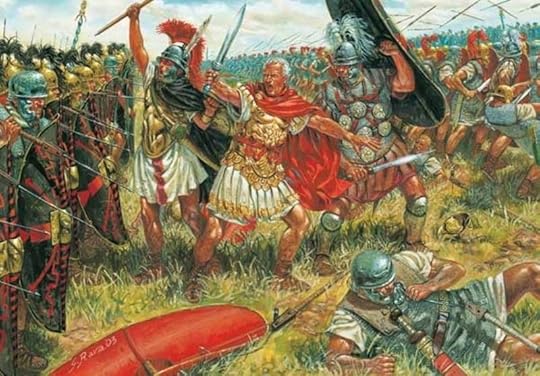
45 BC In his last victory, Julius Caesar defeated the Pompeian forces of Titus Labienus and Pompey the Younger in the Battle of Munda.
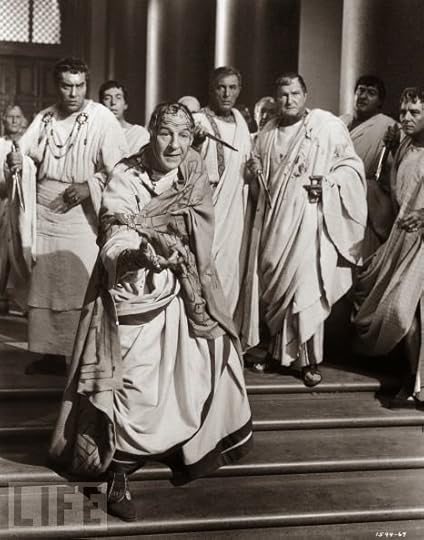
44 BC, the conspirators in Julius Caesar's murder were granted amnesty in a short-lived reprieve before Mark Antony stirred the people to take revenge on them.
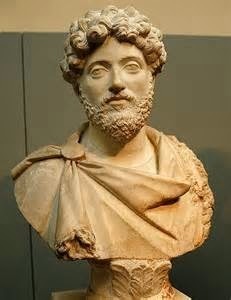
180 AD, Marcus Aurelius died in his camp-bed during a campaign along the Danube frontier, and Commodus became the sole emperor of the Roman Empire.
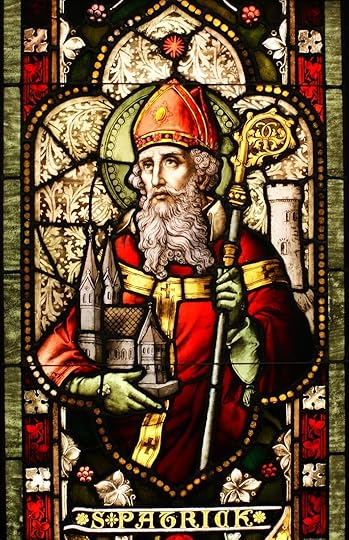
461 St. Patrick, the patron saint of Ireland, died in Ireland at an approximate age of 72.

1337 Edward, the Black Prince was made Duke of Cornwall, the first Duchy made in England.
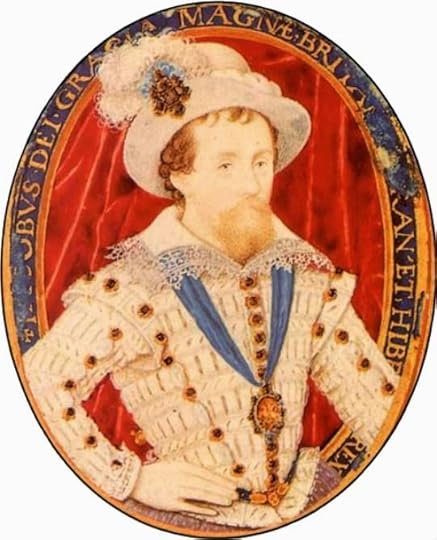
1473 King James IV of Scotland was born. His marriage to Margaret Tudor, daughter of King Henry VII, helped stabilize relations between the two countries.

45 BC In his last victory, Julius Caesar defeated the Pompeian forces of Titus Labienus and Pompey the Younger in the Battle of Munda.

44 BC, the conspirators in Julius Caesar's murder were granted amnesty in a short-lived reprieve before Mark Antony stirred the people to take revenge on them.

180 AD, Marcus Aurelius died in his camp-bed during a campaign along the Danube frontier, and Commodus became the sole emperor of the Roman Empire.

461 St. Patrick, the patron saint of Ireland, died in Ireland at an approximate age of 72.

1337 Edward, the Black Prince was made Duke of Cornwall, the first Duchy made in England.

1473 King James IV of Scotland was born. His marriage to Margaret Tudor, daughter of King Henry VII, helped stabilize relations between the two countries.
Published on March 17, 2014 04:23
March 15, 2014
Crowd-funded publisher, Britain’s Next Bestseller, launches Kerry J Donovan's Sci-fi Thriller - The Transition of Johnny Swift
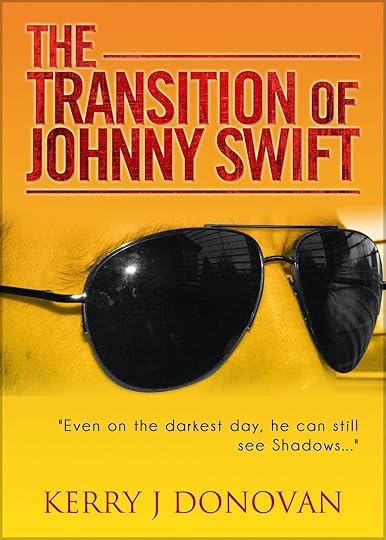
Kerry says:
Come and join us for fun contests and great prizes on April Fool's Day to celebrate the launch of my new novel, which will be available for pre-order from Britain's Next Bestseller from the 28th of March onwards: (http://britainsnextbestseller.com/).
If I generate enough orders, I'll receive a full publishing contract from BNBS, so I appreciate everyone's support in helping me reach this goal.
I'll be sharing more about the book and the prizes soon, but here is a taste of what's up for grabs:
~ 2 x signed paperbacks of my crime novel, DCI Jones Casebook: Ellis Flynn!
~ PLUS a FREE e-version of DCI Jones Casebook: Ellis Flynn for EVERY pre-order of The Transition of Johnny Swift! Thats two full novels for the price of one!
~ My crime novelette, DCI Jones Casebook: Raymond Francis Collins will be going free sometime in the next fortnight, and I'll announce it here first!
~ a $25 Amazon Gift Card
~ 16 e-books from a wide range of fabulous UK and international authors
~ 5 other paperbacks
And two grand prizes for the other authors out there:
~ A Professional Poetry Critique
AND
~ A Professional 5000 word copy-edit from a Former Editor of the Daily Mail Online!! Click on the link to participate: https://www.facebook.com/events/722032794514365/?notif_t=plan_user_joined Tuesday, April 1 at 6:30pm in UTC+01
Blurb:
"When twenty-four-year-old racing driver, Frank Brazier wakes in a hospital bed after a horrific rail crash, he’s blind, wracked in pain, and confused. He’s hallucinating, hearing voices. The voices call to him from the darkness.
In the next room, his sister, Paula, is on life support. The doctors say she’s dead and want to pull the plug, but Frank knows better—one of the voices he hears is from Paula!
Frank has no one to turn to for help, but his girlfriend, Jenny, and the mysterious, ominous Shadow-man. But who is the Shadow-man? What’s his game..."
Comments please, but only if they're nice.
More tomorrow, when I'll start giving you some information on the cast of characters. Starting of course, with the lead, 'Fiery' Frank Brazier...
Some Background Info:Kerry J Donovan was born in Dublin in the late 1950s, before the time of mobile phones and twenty-four-hour television. He spent most of his life in the UK, and now lives in Brittany with his long-suffering wife of thirty-seven years. He has three children and three grandchildren, all of whom live in England. He is an absentee granddad and praises the advent of video calling.
Kerry earned a first class honours degree in Human Biology, and has a PhD in Sport and Exercise Sciences. He earns a living as a furniture designer/maker and writer. He is a regular contributor to UK-based hobby magazines, and writes the occasional short story for online magazines, Gore!
Family apart, Kerry has three loves: making furniture, sport, and writing (but not necessarily in that order).
For as long as he can remember, he has written for pleasure. Now the children are grown, he is devoting more time to his fiction writing.
Kerry published The DCI Jones Casebook: Raymond Francis Collins, in May 2013, and the second Casebook installment, Ellis Flynn in November 2013. Both are available in e-versions, and you can buy Ellis Flynn in paperback.
In March 2014, crowd-funded publisher, Britain’s Next Bestseller, invited Kerry to be one of their launch authors. They loved his Sci-fi/Thriller, The Transition of Johnny Swift, which is due for publication in the summer.
Contact info:
Web pages: http://kerryjdonovan.com/
Facebook page: https://www.facebook.com/KerryJDonovan?fref=ts

Published on March 15, 2014 18:52



